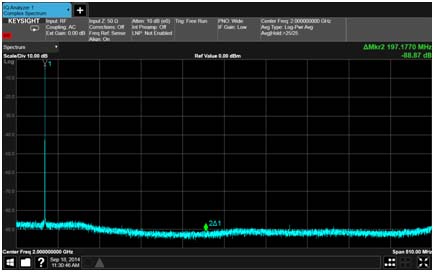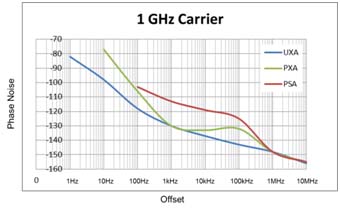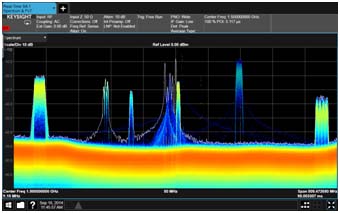For decades, spectrum analyzers have been used in the development and characterization of radar and electronic-warfare (EW) systems. However, traditional swept measurements are rapidly becoming insufficient for today’s agile and adaptive systems. This is driving the need for a solution that delivers significant speed, flexibility and performance, and also has the headroom to handle next-generation needs.
That’s why Keysight created the UXA signal analyzer. As the new flagship of the X-Series signal analyzers, the UXA leverages proprietary technologies to achieve new benchmarks in performance.
Addressing leading-edge requirements
The UXA enables analysis of today’s wideband systems by providing 510 MHz of instantaneous bandwidth, and this extends up to 900 MHz bandwidth using the IF output. The instrument provides industry-leading performance in three key areas: phase noise, wideband spurious-free dynamic range (SFDR) and wideband flatness.
For those who need even more performance, optional real-time spectrum analysis (RTSA) covers the full analysis bandwidth and provides 100-percent probability of intercept (POI) for signals with durations as short as 3.517 µs (at 510 MHz bandwidth). The optional external atomic frequency reference provides exceptional long-term stability.
To enhance usability, the UXA provides a streamlined, touch-driven interface through a 14.1-inch display. The multi-touch display simplifies measurement set up through the familiar X-Series menu structure. By providing wider, deeper views of elusive and wideband signals—known and unknown—the UXA enables users to see more and take their designs farther.
Achieving unsurpassed purity and clarity
Progress in RF and microwave technologies is a complementary, back-and-forth process: new technologies lead to better tools, these lead to enhanced technologies, and the cycle continues. Today, this type of interplay has driven the development of the UXA. Several of its exceptional performance figures are the result of a new analog-to-digital converter (ADC) and a new digital-to-analog converter (DAC). Both are proprietary, Keysight-designed devices, optimized for RF and microwave applications such as radar, EW and wireless communications.
The metrology-grade ADC provides a combination of bandwidth and low distortion that is ideal for optimizing today’s ultra-wideband systems. Using this technology, the UXA can maintain very high SFDR over its maximum instantaneous bandwidth, as shown in Figure 1. This is useful for design tasks such as evaluating the sensitivity of wideband EW equipment and tuning the operation of digital pre-distortion compensation in the latest multi-band or wideband wireless systems.

Figure 1. The Keysight-proprietary ADC maintains high dynamic range over the UXA’s full 510-MHz bandwidth. In this measurement, the largest spurious product is more than 88 dB below the level of the main signal.
The ADC does not operate in isolation. To maximize converter performance, the UXA employs a wideband RF front-end assembly with flatness of less than ±0.7 dB over the full IF bandwidth.
While the ADC is clearly important to analyzer performance, the value of a wideband DAC is less obvious. Here, the Keysight-proprietary DAC is essential to fundamental performance improvements, providing an outstanding combination of phase noise and low spurious distortion.
The DAC is the central component of a direct digital synthesizer (DDS), which complements the traditional PLL-based local oscillator (LO) found in spectrum and signal analyzers. Because the LO is used in all frequency-conversion operations, its purity and frequency stability are reflected in the signal analyzer’s spurious and phase noise performance figures.
The phase noise benefits of the DDS-based LO are impressive, especially at low and moderate carrier offsets, as shown in Figure 2. One remarkable consequence of the DDS-based architecture is the absence of a pedestal in the analyzer’s phase noise curve when the DDS is used by itself, without a PLL. The shape and corner frequency of the pedestal are governed by the PLL’s loop-filter characteristics, which are sometimes user-adjustable as a way to optimize phase noise performance in specific offset regions.

Figure 2. Compared with its high-performance predecessors—the Keysight PXA and PSA—the UXA offers improved phase noise, especially at close-in and medium offsets.
In the UXA, the absence of a pedestal means that improved performance is available over a wide range of offsets up to about 1 MHz. For very wide offsets, a PLL is used along with the DDS to get a lower phase noise floor from the YIG-tuned oscillator. When needed, the PLL also provides loop filtering and avoidance of DDS spurs.
As with the ADC, the DAC does not operate in isolation. For example, the close-in phase noise performance of the UXA is the result of a new frequency-reference assembly. The design of the reference was optimized to take advantage of the DDS characteristics and improve phase noise performance, especially for offsets narrower than 100 Hz.
Extending real-time performance
The 510-MHz instantaneous bandwidth is coupled to ultra-fast digital signal processing (DSP) to more than triple the widest real-time bandwidth currently available in a general-purpose signal analyzer. With the RTSA capability, the UXA provides 100-percent POI—with full amplitude accuracy—for signals with durations as short as 3.517 µs over the 510 MHz bandwidth, and it can detect elusive signals as short as 1.5 ns (Figure 3).

Figure 3. The UXA sets new benchmarks for real-time bandwidth. The spectral density display is a powerful way to reveal fleeting or otherwise elusive signals and signal behaviors.
Real-time is also used to implement frequency-mask and time-qualified triggers. As a result, the UXA can distinguish between spectrally similar signals based on their time characteristics, and it can trigger on pulses shorter or longer than others. As an example, this capability could be used to find transient interferers in the middle of a dense wireless signal environment or to identify specific emitters in spectra from a battlefield.
Seeing through complex signals
The full instantaneous bandwidth of the UXA is also available for use with the 89600 VSA software, either inside the analyzer or through a networked PC. Frequency-mask, time-qualified and other real-time triggers can be configured to initiate individual measurements and gap-free signal captures for post-processing.
Because signals are captured in complete vector form, post-processing can include changes to center frequency and span, with no need to capture new data. This technique can capture several signals at once, potentially including multiple frequency channels or bands. Individual signals can then be extracted from the capture for any type of analysis, including demodulation and time alignment or detection of cause and effect.
The wide acquisition bandwidth of the UXA expands the VSA’s multi-measurement capability. For example, simultaneous demodulation measurements can be made from a single acquisition, covering different modulation types and bandwidths. Analysis can include modulated signals, interferers, and other signal types, all at the same time.
Continuing the cycle
The UXA X-Series signal analyzer is the latest iteration in the complementary, back-and-forth cycle of improvement that encompasses new technologies, new tools and new developments. Built on Keysight-proprietary technologies, the UXA delivers unsurpassed purity and clarity in signal analysis. The excellent IF section enables deeper understanding what’s happening inside a system and, ultimately, helps the designer prove that it’s meeting or exceeding its leading-edge performance goals.







